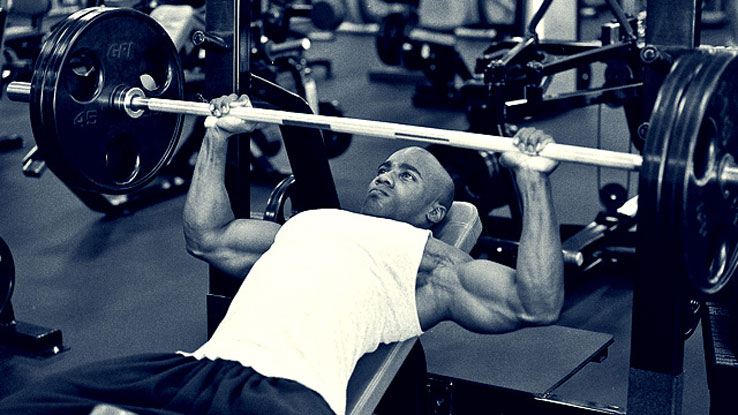Here's what you need to know...
- Don't change exercises just for the sake of change. Choose exercises that you can progress for at least 3 months.
- Lifts need to be repeated for technique to improve and for the body to adapt. If a lift or muscle group is worth including, it should be included at least twice per week.
- Train the big lifts explosively and for lower reps to build power and strength. Train the isolation lifts slower and for higher reps to build muscle.
- Write out your training program and record every set with weights and reps. If you don't, you're wasting your time.
Training programs are often designed haphazardly and without proper respect paid to the goals. Without solid planning, it's easy to find yourself no stronger, no leaner, and no more athletic, even after months of hard work. The following are common mistakes found in training programs, many of which often go unnoticed.
If you consider strength or bodybuilding goals to be lifelong commitments, then exercise choices should be seen as a marriage. Every time I see a "new" exercise I ask myself why I'd choose it, and if I did, how would I progress it?
Unilateral exercises are a good example of something that needs consideration, especially offset movements that challenge the core such as lunging with a dumbbell in only one hand. Exercises of this ilk become obsolete once you get strong enough to exceed your ability to balance, assuming you're not training for Cirque de Soleil.
Sure, you get some nice oblique recruitment from offset dumbbell lunges, but if you're strong enough to only have your balance challenged, continuing to perform them means you cease getting stronger.
Even high-quality unilateral movements like the Bulgarian split squat get out of hand. I consider it far more dangerous to have 225 pounds on my back while standing on one leg than to have 450 supported on two legs.
Loading aside, it's downright scary to think about progressing Bulgarian split squats for a lifetime – 400 pounds per leg? Many exercises are only sensibly progressed to a point, after which they're rendered ineffective, unsafe, or incongruent with goals.
Takeaway
Choose only exercises that you could progress for at least 3 months, and keep them on your program for at least that long. Do this because increased strength should always be a long-term goal, even if you're just into bodybuilding.
Furthermore, know that barbell lifts are always going to allow the heaviest weights, along with infinite progress. Dumbbell work and unilateral exercises may only be progressive depending on your current level of strength.
Like everything, lifts need to be repeated for technique to improve and for the body to take to the stimulus. For most (powerlifters on programs such as Westside being a notable exception), every lift worth including needs to be performed at least twice per week. This will allow technique to improve and more rep ranges to be trained, concurrent with the training goal.
This could mean multiple sets of a variation on an arm day for bodybuilders, or multiple sessions per week for those like athletes who need to squat, jump, or sprint. If a worthwhile lift is only performed once per week, it's likely not going to improve, and if it's unlikely to improve, why bother?
Takeaway
If it's important to your goals, be sure to allot ample sets/reps/intensity. This probably means at least two sessions or six sets per week. Three sets of anything once per week won't have an effect.
If your goal is to build muscle without regard to power output, go slowly and stress the eccentric. If your goal is to build power and absolute strength, move the weight as fast as possible. And, within the same workout, don't forget which exercises are for which.
The big lifts are, well, the big lifts, so if you want to move bigger weights you need to recruit more of your available force. More motor units are recruited and sticking points are less troublesome when the bar moves at high speeds, or at least with the intent to move at high speeds.
Don't forget that assistance work is aptly named – these exercises build muscle and strength to assist the big lifts. So if your back needs to thicken to support a heavier deadlift, then use a slower tempo along with the higher reps. It'll build more muscle.
Time under tension is the goal, which is why I routinely yell "slow down!" at my 15 year-old athletes as they speed through 8-rep sets. Until they do, they'll continue to be scrawny.
Takeaway
If the rep range is 5 or less, it's heavy. Move the weight fast because moving the weight is the only goal. If the rep range is 6 or more, it's an assistance lift designed to build more muscle. Slow it down, feel the muscle and milk the eccentric (2-4 seconds is ideal) to get more time under tension.
As you become an advanced lifter, gains taper off and adding 10 pounds per month to the big lifts is a big task. To not have a pen and paper program means weights and reps get forgotten.
Did I use 245 pounds or 265 last week? Did I get 6 reps or 7? When fighting to add just a few pounds to the bar, these little differences matter, and when weights or reps get forgotten, the wrong weights get added to the bar. Wrong weights means the wrong training stimulus, which in turn means that your stimulus isn't pushing you toward the goal you've set.
Takeaway
Spend an hour on Excel creating a spreadsheet. Tweak it until you love it and it makes your recordkeeping easy. Then, take the time to write out your training program and fill in each and every set with weights and reps. If you don't, you're wasting your time.
If you're not good at it, you need to work on it. People who have a meal with me often notice a pattern and ask me about it.
"Why do you eat your foods in groups, they ask?"
Well, I eat the worst-tasting foods first. That way, I always finish with a good taste in my mouth. I shovel the broccoli in, leaving my steak and sweet potato for last – the flavors I want to linger.
Training can be the same. If you suck at something, it's probably good for you in the same way as those green veggies. To continue to bring your weaknesses up to assist your strengths, you'll have to program and make time for lifts you hate. But that's not to say that you can't still do the ones you love. And if you want to add motivation to get through it, put something you enjoy last in line. That way you can push up the hill knowing you can coast down at the end.
Takeaway
Your weaknesses need extra attention to keep the gains coming. It'll suck, but program them in. Orient your program in a way that puts something fun at the end. That way, you can grind through the hard part knowing something fun lies ahead.
Look closely at what you've been doing and clean up those bad habits. Marry the most important exercises, build up your weaknesses, pay attention to tempo, and keep good records. Make a few changes today and you can keep climbing.




